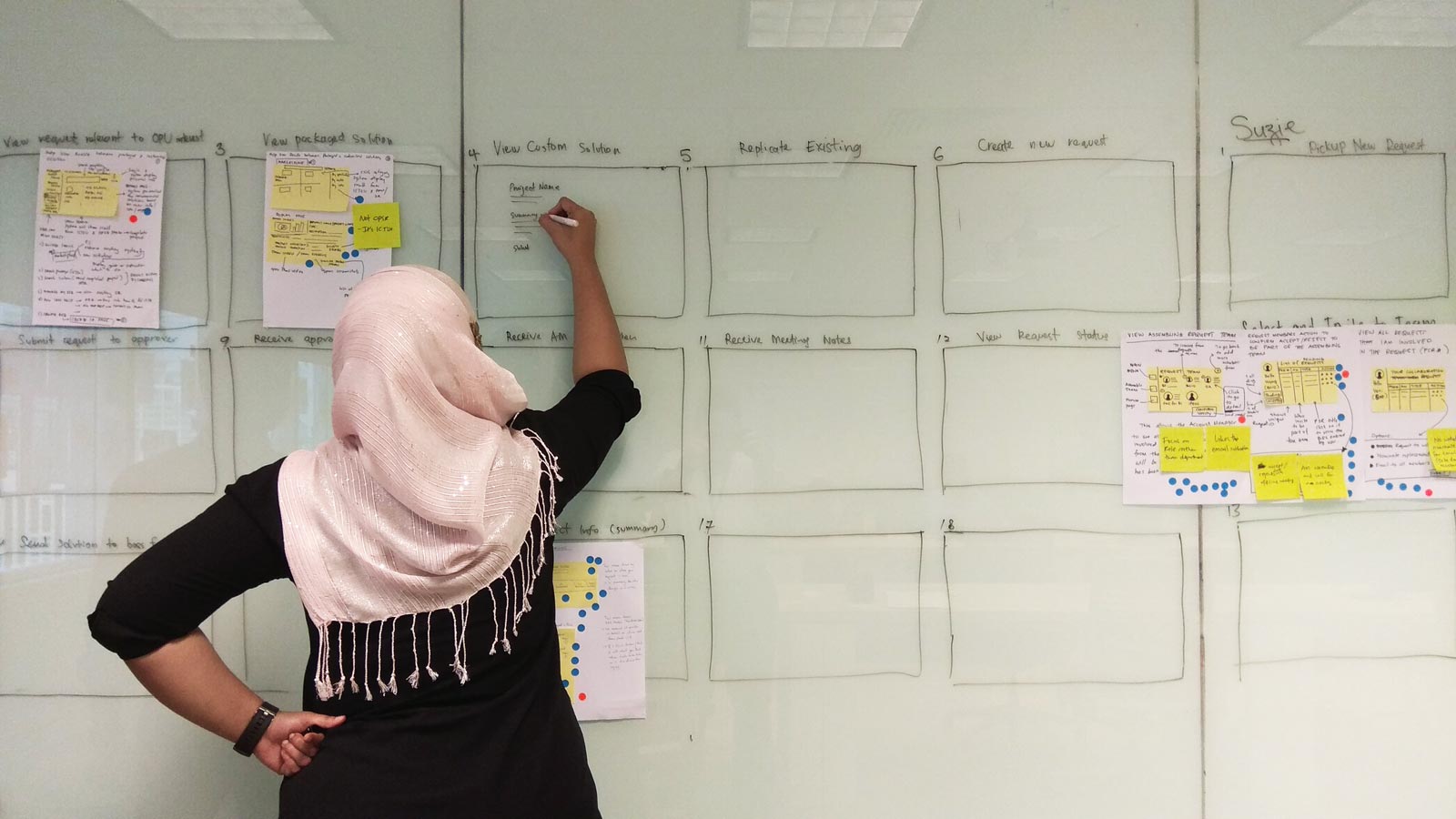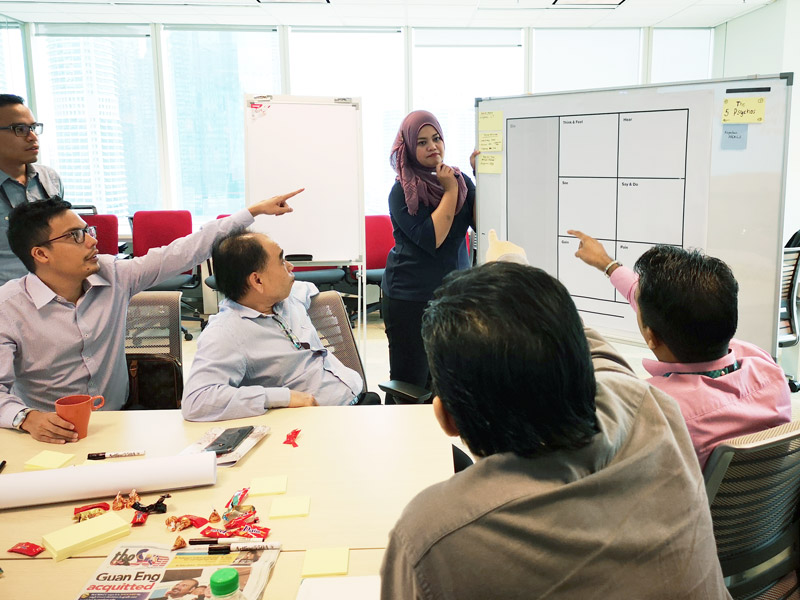At the core of it UX is about solving problems. And to solve problem you first need to single out the signal from the noise. Given the intricacies of business and complex user behaviour, where do we start? How do we even know which question to ask?

What do we ask?
The first step of finding a solution is making sure you have the right problem. This is where you have to sieve through a lot of information and noise with the hope that the there’s a signal at the end of line. There are several ways to do this, including user research, interviews and workshops. Throughout these sessions, you will have excellent opportunities to dissect a business and ask questions as an outsider looking in.
With so much to ask, how do we know which are the right questions? As a rule, we avoid asking leading questions such as:
- “tell us what you need”
- “will exporting to Excel spreadsheet work for you?”
- “would you like to have a white or black dashboard?”
- “what do you think about this feature?”
Doing so will result in only cosmetic solution that doesn’t solve the real problem. It will not lead to a transformative result that will create the impact your client is looking for. It is hollow and you, the designer, know it.
Instead, we try and ask questions like
- “what are problems you face when performing this task?”
- “which information helps you make more informed decision?”
- “what is the goal of your task?”
- “how does achieving that goal contribute to your KPI?”
- “who do you rely on to accomplish that goal?”
This helps re-frame the discussion from being feature-oriented to being user-oriented. After all, we’re not designing for system. We’re designing for people.
Who do we ask?
At Stampede, we start asking preliminary questions very early on in the client engagement to get an idea of the complexity at hand. We then develop loose hypothesis to help guide the early stage discussions.
The peak question-vaganza though happens during our UX workshops, a joint focused session that can last between 1-4 days depending on the complexity of the problem. This is where we bunker down with our users and stakeholders to gain clarity on the right problem and validate our hypothesis.
If you don’t have access to the end users, the customer-facing team is the next best thing. They are the front-liners who deal with the end-users the most.
They mitigate frustrations, troubleshoot issues and work with the end users day in and day out. Having them join your discussion will reveal things about your users that sometimes even the CEO is unaware about.
“But these users don’t know what they want!”
We hear this often, especially in organizations where there’s a deep-rooted culture of supremacy over users. The truth is, the more you practice UX, the more you realize you don’t know things. And that every UX session with the users are accelerated learning process for the UX designer, not the other way round.
I think the users know a great deal about the problem they’re facing. They may not know the solution to the problem but then again, it’s our job as UX practitioners to design the solution for them.
Many of us however are not equipped at asking them right questions. Nor are we willing to, if it will upset the way we have always done things.
Guiding principle check
This is where your guiding principles will help you decide. Ask the right question, and you will get closer to the right solution.
Keep asking the wrong ones, because it’s easier and comfortable to do, and you might end up delivering the wrong solution. In doing so, the client would have wasted their money and time—they just don’t know it yet. It’s akin to applying a new coat of paint to a crumbling house—the people outside is impressed by the new façade but the people inside had to cope with the danger of their roof collapsing.
You’d also rob the user of the experience of enjoying a task because they will continue to serve inefficient process and forced to learn using new interface with every “redesign”. And the redesign will keep coming because the problem is never really addressed.
It’s the same circus, just different hoops.
Asking the right questions
At Stampede, we ask questions a lot. You don’t have to prompt us “any question?” because we will keep asking until the session ends or someone stopped us. Our team appreciates curiosity and inquisitiveness big time. We believe that to ask good questions, you first have to ask A LOT of questions. And then you wait for the Law of Averages to kick in after your 100th questions, and then you learn again and that’s how you get better at it.

The good news is, we already have it in us to ask the right question. Asking the right question help us guide our mental exertion towards a worthy focus. We’re not solving superficial problem, we’re solving actual problem affecting real people. For a designer, the power to do this gives us a glowing wholesome feeling. I still get goosebumps when this happens.
Asking the right question takes some experience, but I have learnt that a good listening skill expedite that fairly quickly. When you start a UX consultation session with client, walk into it thinking “I have so much to learn from this” and you will find yourself a better listener. You will start using questions as a tool not to lead the outcome in your favour, but to encourage clarity and design-thinking in everything you touch.
Make it count
As UX practitioners, we have the time, the skills, the team and the resources to make this happen. We can solve users and organizational problems through design-thinking and have it ripple across the board. It will touch so many more people than we originally intended too.
Imagine an engineer enjoying his work more now that he won’t need to wait anymore for an Excel macro to run for an hour before spitting out results needed to start his day. Heck, he will now achieve his daily goals with time to spare. Everything he needs to make a good decision is at his fingertips.
In return, he can pay closer attention to the critical aspect of his job because he knows he now has the right and timely tools to solve his problems.
Perhaps when he drives home, he drives better because his mind is less occupied with problems to solve.
And perhaps he is happier to arrive at work the next morning because he knows his skill and expertise are going to be spent being fully productive, making positive change to his organization.
And because happiness attracts, perhaps he will influence others like him to always be looking to continuously improve things. And they in return will influence others like them. And their organization will pave the way for others in the industry to follow.
Goosebumps?
